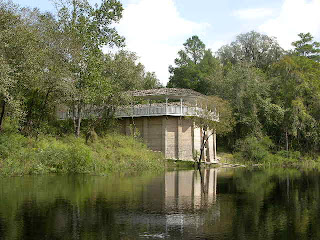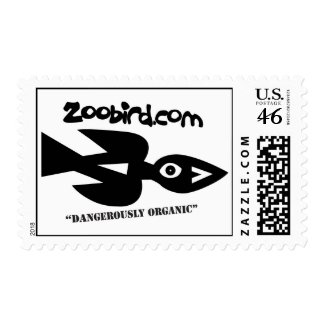Dangerously organic!
We're not getting older, we're getting smarter. For instance, many college
kids' idea of a good time is to go downtown, hit the bars and get
soaked to the gills in toxic liquids. "Seasoned" paddlers, on the other
hand, prefer going down rivers, stopping at occasional sand bars and
drenching ourselves in cool, refreshing water. Best of all, we rarely
wake up the next morning in the neighbors marigolds. And, as
experienced paddlers will attest, the finest bars in our area are those
along the upper Suwannee.
Happy Hour on the Suwannee will be this Sunday at 9 AM. On Tuesday, you'll have another chance to wet your whistle on Weeki Wachee River. Wanna go?
- Sunday, August 8: BAR HOPPING down the SUWANNEE
This trip will have us on the first leg of the Suwannee River Wilderness
Trail (SRWT), starting at Hwy 41 Bridge in White Springs and paddling
the first 8 miles of the Trail down to Blue Sink. This will be about a
4 hour paddle, including lunch and swim stops. Our meeting time will be
9 AM at the river, about 1 hour North of Gainesville.
The cost is $35 for "wanna go" members ($45 for all others). With your own boat it's $25 for members and $35 for others.
Description
The sand bars that line much of this stretch are not only attractive; they
make excellent pit-stops for a quick jump in the river. The biggest are
"point bars," formed on
sharp bends in the river where sand is deposited by the water as it
slows going around the inside of the bend. Growing conditions for
plants are harsh on point bars. When plants do take hold, a predictable
succession forms, starting with tough, low herbs and grasses, followed
by shrubs and finally trees. Black willows commonly top the bar.
Behind the sand bars, there’s limestone. Few places in North Florida showcase
limestone more beautifully than the section we’ll paddle on this trip. Whether
it’s individual stone outcroppings along the lower river, or massive,
40-foot stone walls, there are few places along this stretch without
limestone.
This cream to grey colored sedimentary rock was formed during times when the
world’s water levels were much higher than today and Florida lay at the
bottom of a shallow sea. Shells and cartilage of sea creatures settled
on the sea floor and accumulated in layers ranging from several feet to
nearly half a mile thick. Most of what we’ll see on this trip is
Suwannee limestone, formed on the floor of a sea that stood here nearly
35 million years ago.
Among the more interesting fossils found here are those of ancient dugongs,
ancestors of today’s manatees. In 1982, college students from UF found
the skull and partial skeleton of an extinct manatee on the riverbank
near White Springs. These creatures lived in the shallow sea that
covered this area 20 million years ago, during the Miocene era.
Paleontologists soon uncovered three more specimens. Of the four, one
belonged to a previously unknown genus, one was the first skull of its
genus and one was the best preserved specimen of its species ever
found. Two of the animals were from a subfamily of sea cows previously
unknown in the New World. Interestingly, all appear to have co-existed.
Imagine the manatee tours we would have had!
Wildlife
The plant communities along this part of the Suwannee reflect the higher,
drier terrain flanking this section of the river. The combination of
high, sandy banks and dark, tannin-stained water, makes aquatic
vegetation relatively scarce. This, in turn, means fewer fish species
and a less complex web of life.
But on shore there's no shortage of greenery. Lanky, coastal plain willows,
river birch, and Ogechee tupelos along with a number of sedges and
grass species cling to the higher, firmer sand banks. On top of the
bluffs, an unbroken forest of oaks and pines rule the high ground. It's
a fairly remote area and animals such as deer, bobcats, hogs, turkey
and an occasional bear come to the water’s edge for a drink although
sightings are relatively scarce. Also residing in this stretch of the
river is a fair number of beavers. You don't have to look hard to see
their sign, which includes some impressive, long slides which they use
to skid limbs, branches and other woody munchables down to the river.
Keep an eye out for otters, as well.
Birds are more scarce here than other sections. But, we do see above-average
numbers of Mississippi and swallow-tailed kites in the spring and
summer months. Eagles, osprey and vultures are commonly seen soaring.
History
When Bryant Sheffield started a plantation on the Suwannee in 1835, he
became owner of a fabled spring, known at the time as Suwannee Sulphur
Springs. Today, we know it as White Spring. While this mineral-rich
spring had long been considered sacred by the indigenous peoples,
Sheffield was more concerned with feeding his family than his soul
and promoted the health-giving spring as a Fountain of Youth.
 Business was good and soon he built a hotel and springhouse alongside the
spring. Later owners replaced the log springhouse with a larger
Business was good and soon he built a hotel and springhouse alongside the
spring. Later owners replaced the log springhouse with a larger
concrete and coquina structure, the remains of which still
enclose the meager spring. In its heyday, late in the 1800’s the town had 14
hotels, a cotton gin, several mills and stores. But, the waning health
spa fad, coupled with a devastating fire in 1911, brought an end to
White Springs’ growth.
Later in our trip, we’ll stop in at Woods Ferry River Camp, a feature of the
SRWT. If you ever camp here, you’ll be continuing a tradition that
dates back nearly 12,000 years. Archaeological evidence suggests that
people from all prehistoric cultural periods used this high bluff,
including the first Floridians, nomadic Paleo-Indian hunters, whose
diet included such exotic Suwannee fare as mammoths, mastodons, giant
ground sloth and early ancestors of camels and horses. While some may
have lived here for extended periods, this was primarily a hunter’s
camp. Today’s campers will find accommodations a bit more comfortable
than their earlier counterparts, with five screened camping
platforms, heated bathrooms, warm showers, potable water and picnic tables.
Notes
- After our trip, you might want to drive around White Springs and look
at some of the fine old homes. You should also consider visiting one of
the town’s newer buildings--the Nature and Heritage Tourism Center at
the intersection of SR 136 and US 41. There, in addition to self-guided
tour pamphlets, you’ll find shelves full of information about Florida’s
historic sites, parks and attractions.)
- Another interesting place to visit is the Stephen Foster Folk Culture
Center State Park. If you’re within earshot any day at 10:00 AM, noon,
2 or 4 PM, you’ll be treated to the bells of the Carillon Tower. This
park is also the site of the famous folk festival. Soon after acquiring
the land for the Folk Center in the 1950’s, the Florida Folk Festival
was established to showcase the State’s music, history and local
traditions. Call ahead for dates of park events such as arts and crafts
demonstrations and workshops. Without a doubt, the park’s most popular
event is the Florida Folk Festival, held every Memorial Day weekend.
Those of you who have been on trips with me before know that we like to
go slow, taking in the sights and sounds around us, (although you're
welcome to go at your own pace) - speed's not an issue.
at the river at 10:00 AM. It's about 1.5 hours south of Gainesville, 1
hour north of St. Pete and 1.5 hours west of Orlando.
marshes as it enters the Gulf of Mexico. On this trip we will be taking
out just before the salt marshes. It's proximity to the Gulf also makes
this river strongly influenced by the tides. It never reverses flow
like the Waccasassa, but it's flow rate fluctuates dramatically.
as egrets, herons and cormorants. A very unique element of this first
stretch is the presence of pelicans. They, along with their wood stork
buddies, have a strong affinity for this area. Behind the marsh
vegetation, on both sides, the river bank rises sharply, reaching 25 to
30 feet in some places. These sandy white bluffs are relict dunes and,
as with the ancient dunes we encounter on other trips, these are topped
by open, dry scrub habitat. Those familiar with this increasingly rare
habitat will recognize the lanky, widely spaced sand pines that are
characteristic. It's not surprising that in one old account, Weeki
Wachee spring was referred to as White Mountain Spring.
narrow channel winds through a mature, often closed canopy of cypress,
bay and gum in an excellent subtropical mix with sabal palms and
hollies.
of re-entering civilization.
pre-pubescent boy's childhood was complete without a trip to the Weeki
Wachee mermaid show.
by memories of the death-cloud beer burp which the 'Jolly One' wafted
into my face as I sat on his lap referencing pages from the Sears
catalog's toy section - but that's another story). For me, the grand
disappointment happened when I was six. I had always been able to
overlook the mermaids' frequent visits to the bubbling air hose. And,
while they were a bit troubling, I was even able to ignore those weird
little bubbles which fizzled between the teeth of their otherwise
perfect smiles. But, after the show on that fateful day, when I spotted
my beloved 'goddess of the deep' sneaking out the "Gulls Room" door,
walking, unmermaid-like, on two feet and trailing a streamer of
Charmin's extra-absorbent from her penny loafers, the dream was
shattered.
coming back to this river, not to stare puppy-eyed at the sirens behind
the glass, but to explore the river overhead, he'd have probably choked
on his Jujubee's.
Otters are also common. On a couple of our trips last winter we saw
Little Eddie, the one-eyed otter who some of us first met 4 - 5 years
ago. At the time, he was a pup, playfully floating on his back, riding
back and forth on a strong eddy current (thus the nickname). We often
spotted him on subsequent trips, but then didn't see him for over a
year. I was becoming concerned for his well being until we saw him
again last year. Hopefully we'll find him alive and well again this
winter. To top off the day, there's a nice, casual restaurant with open
deck overlooking the river where you can relax with a cool drink and/or
food after the trip.
will be able to contact us, b.) that there will still be spaces
available, c.) we have not already left the store with the boats. The
earlier you call, the more likely you are to secure a spot.
message, though a significant number of electrons may have been
inconvenienced.
Comment
© 2025 Created by Michael Levin.
Powered by
![]()








You need to be a member of Zoobird to add comments!
Join Zoobird